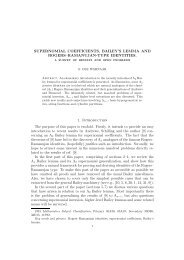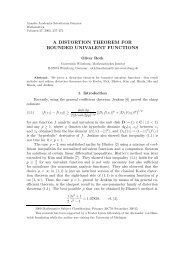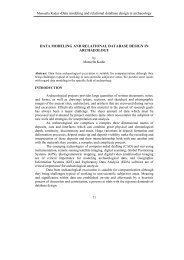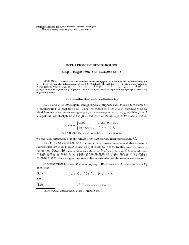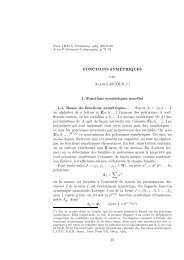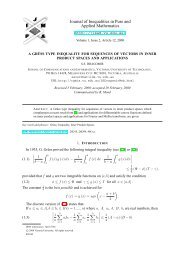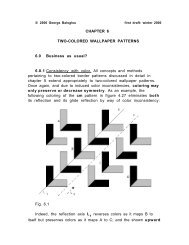THE COMBINATORICS OF THE AL-SALAM-CHIHARA q ...
THE COMBINATORICS OF THE AL-SALAM-CHIHARA q ...
THE COMBINATORICS OF THE AL-SALAM-CHIHARA q ...
You also want an ePaper? Increase the reach of your titles
YUMPU automatically turns print PDFs into web optimized ePapers that Google loves.
<strong>THE</strong> <strong>COMBINATORICS</strong> <strong>OF</strong> <strong>THE</strong> <strong>AL</strong>-S<strong>AL</strong>AM-<strong>CHIHARA</strong> q-CHARLIER POLYNOMI<strong>AL</strong>S 115.3. Involution. The weight function in Equation (5.1) has many cancelations. Wewill give a combinatorial weight-preserving sign-reversing involution φ with fixed setΠ(n 1 , n 2 , . . . , n k ) defined on the set of all Charlier-partitions of type n.Let (τ, ν) be a Charlier-partition of n. The involution φ will be defined depending onthree different cases of (τ, ν).Case 1. If (τ, ν) has a circled 1-cycle in a block by itself or a boxed 1-cycle, thendefine φ(τ, ν) by picking up the smallest 1-cycle and switching its box to circle or viceversa. Since a boxed 1-cycle contributes −a and a circled 1-cycle a, φ is weight-preservingsign-reversing in this case.Case 2. We now assume that (τ, ν) has no 1-cycles, boxed or circled in a block by itself.Find the rightmost integer α, if it exists, in τ, say in τ i , such that it has a neighbor β inτ i , along the straight edge or an arc, to its right.Case 2.1. Assume that α and β are in the same cycle σ ending with α β, i.e. σ = (· · · α β).Since α is the penultimate entry in σ, β is not the maximum in σ. Suppose the contributionof β to Cinv(τ i ) is j. Then τ i is of the formτ i = (· · · ) · · · (· · · α β)(t m )(t m−1 ) · · · (t j+2 )(t j ) · · · (t 1 )with t 1 < t 2 < · · · < t m and t j+1 = β. Let τ ′ i = (· · · ) · · · (· · · α)(t m )(t m−1 ) · · · (t 1 ). Integerst m , t m−1 , . . . , t j+2 are moved to the left by one step and β occupies the position of t j+2 .We make some changes on the diagram of (τ, ν) as follows, to obtain the diagram of theCharlier-partition (τ ′ , ν ′ ):Algorithm: Stretch• Initially, start with the diagram of (τ, ν) with all arcs and edges.• Delete the straight edge between α and β in the diagram.• Rearrange t m , t m−1 , . . . , t 1 in descending order, leaving the arcs and edges intactin their present positions.• For l from m − 1 down to m − j, make the arc arriving from left at the positionof t l to arrive at t l+1 , if it exists; if there is no such arc at position t l and thereare no arcs at position t l+1 , then make the arc arriving from right at position t l toarrive at position t l+1 .• Add an arc between α and t m−j .Let φ(τ, ν) = (τ ′ , ν ′ ). We need to show that φ is a weight-preserving sign-reversinginvolution. The involution part will be clear after the next subcase is introduced. Clearlywe have w(τ ′ , ν ′ ) = −w(τ, ν) when q = 1, since (τ ′ , ν ′ ) has one more 1-cycle than (τ, ν),contributing −1 to w(τ ′ , ν ′ ). So it suffices to prove that the exponents of q in w(τ, ν) andw(τ ′ , ν ′ ) are the same. This can be done easily by induction on j. The loss in Charlierinversions from τ to τ ′ exactly matches the gain in restricted crossings from ν to ν ′ forall j.The following are some examples with n = (3, 6, 2).



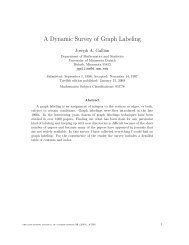

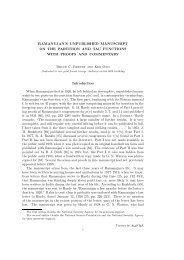
![(.,t ] and [s, .) , where [s,t ] = {s' GT; s ¤ s' ¤ t} , (.,t ] = {s' GT; s' ¤ t} and ...](https://img.yumpu.com/43303393/1/184x260/t-and-s-where-st-s-gt-s-a-s-a-t-t-s-gt-s-a-t-and-.jpg?quality=85)
